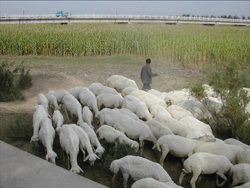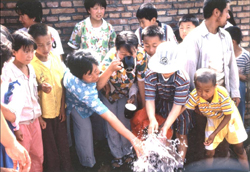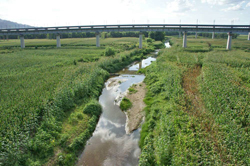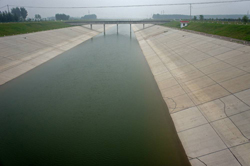Water shortages in Shanxi Province, China, are impacting seriously on agricultural production. As rivers and wells have dried up, some villages lack even enough drinking water. Kunio Takami writes of the efforts to provide water to parched villages, including through well-digging schemes involving his environmental NPO, as well as of major infrastructure projects designed to supply water to Beijing and other major cities.
* * *
Nine Years of Drought, One Year of Floods
In one of the farming villages near the city of Datong in Shanxi Province, where Midori no Chikyu Nettowaku (Green Earth Network) has been involved in reforestation projects for many years, there is a folk song called “How High the Mountains.” For generations local people have sung this song that describes the harshness of the natural environment around them: “The mountains are close by, but there is no firewood with which to cook. There’s drought in nine years out of ten, and in the other comes floods.” It is a short verse—just 16 characters long in the original Chinese. After visiting the region for 22 years, I feel that the words reflect with remarkable accuracy the problems people here face.
The second line of the song is borne out by statistics. Average annual rainfall is 400 millimeters, although in some years more than 600 mm of rain falls. The year 1995 was one such example. There was severe drought until mid-July, but toward the end of the month it began to rain. The rains normally come to an end in mid-September, but that year they continued into October. Many of the local houses are made of earth; rainwater drenched the roofs and walls of these structures, causing many to collapse. The tragedy affected 60,000 households—some 240,000 people in all.
But such years are the exception. Much more frequent are years in which it hardly rains at all. In 1999, for example, the region suffered the “worst drought since the founding of the People’s Republic.” Local farmers got almost no harvest from their maize that year. In upland areas like the Huangtu plateau, many farmers did not even bother to plant a crop that was clearly doomed from the start. The drought, which happened to coincide with the fiftieth anniversary of the People’s Republic, can be fairly described as the kind of drought that comes once every 50 years. The situation was made even worse when another drought hit in 2001, and the mountains were singed brown into the summer months. The scale of this drought was even worse—people said a drought like this came just once a century. The region, hit by a “once-every-50-years” drought, thus suffered from a “once-a-century” disaster just two years later.
Rivers That No Longer Flow

Flowing water has all but disappeared from the major and minor rivers of the province. The Sanggan River rises in Mt. Guancen in the northwest of Shanxi Province, and transects the center of Datong City from west to east. In Datong County, Route S203 crosses the Sanggan via a bridge. Every time I cross the bridge I pause to take a photograph and check the water level. The last time I saw any substantial amount of water in the river was in July 1997, when I watched a local farmer drive his flock of sheep into the fast-flowing waters of the river for a bath. Since then, the running stream of water has vanished, and often the riverbed is absolutely dry.
In Ying County a little farther upstream, the entire riverbed is given over to fields planted with maize; there would be no room for a flowing river here anymore. Here too I take photographs whenever I pass through. In the summer of 2012 I was chased away by farmers who were working in their fields. There are watermelons growing at the back of the fields of maize, and apparently they had mistaken me for a watermelon thief. In the spring of 1993 poplars were planted here to strengthen the riverbanks. When the trees were saplings, the surging waters of the river sometimes used to rush up over their roots. Today, the poplars have grown but the river has dried up.
According to local accounts, this drop in the water level came suddenly. The Yuhe, which flows north to south through the easternmost extremity of downtown Datong, is one of the largest of the Sanggan’s tributaries. Thirty years ago, locals say, there was always plenty of water, and it would have been impossible to ford the river on foot. Now, the flowing stream has disappeared altogether and people have built weirs like pools that serve the park situated on both sides of the river, where treated waste water from the city is stored.
Until recently an iron image of a bull stood in the grounds of the ancient Shanhua Temple. The image, which dates from the Ming dynasty, was apparently placed on the west bank of the Yuhe to pacify the river, which used to flood repeatedly. Now it has been moved to a museum in Datong ready for public display. In East and West alike, it is the job of the bull to fight back against the powers of the dragon who rules the waters.
Digging Wells in Farming Villages
In the drought year of 1993, only 4 of the 11 villages in Sunjiadian, Tianzhen County, produced more than 200 kilograms of grain per person, producing between 293 kg and 528 kg per person. All four were places where underground water makes irrigation possible. In 5 other villages, per capita grain production ranged from just 39 kg to 79 kg. In these villages, almost no irrigation was possible. The minimum amount of grain required to sustain one adult is 200 kg per year. To obtain this, irrigation is essential, and once a village starts on irrigation there is no turning back. Declining underwater water levels are a problem throughout the region.

Drinking water is also a problem in some villages. When we carried out a survey in 21 villages in seven counties in 2000, the most common responses were, “We have no shortage of water and practice irrigation” (42.6%) and “We have water sufficient for our daily needs, but no irrigation is possible” (47.4%). Far fewer respondents chose “We have sufficient drinking water but need to be careful how we use it” (18.3%) or “We lack sufficient water and must get water from other villages” (3.6%).
At first glance, these responses may make it look as though the water shortage problem is not too severe. When we asked about the amount of water required per person per day, however, the average across the 21 villages was 23.8 liters, with a high of 31 liters and a low of 15.6 liters. And 61.6% of respondents said that water availability was decreasing. The percentage was higher in villages that used less water, rising to 70% in Yujiashan, where the average water use was 15.6 liters per person per day.
Wishing to do what we could to help, our organization cooperated with a well-digging project. The village of Yuanxizhuang in Guangling County originally had 20 wells but these gradually dried up so that by 1997 only 4 were still producing water, with local people being able to draw only 100 buckets of water per day. This was divided among 150 villagers and their livestock.
Using donations collected in Japan, we dug a well capable of producing 15,000 liters of water per hour from a depth of 176 meters. This was not enough to support irrigation, but villagers started to plant vegetable plots in their gardens, cultivating tomatoes, cucumbers, and green beans, which they had previously had to buy. We also cooperated on another well-digging project in Shiweng, Lingqiu County, where we reached water at a depth of 183 meters, enough to supply drinking water to three surrounding villages.
Since then, as part of the process of poverty relief, wells have been dug in more villages that were struggling to meet their water needs, and there are no longer villages without adequate drinking water. In this sense, it is fair to say that the effects of economic development are reaching even these poor villages. The last place remaining without sufficient water was the village of Yujiashan, which I mentioned briefly above. The natural spring near the village has hardly produced enough to meet the villagers’ needs, and they were forced to travel long distances to get water from other villages. Using grant assistance for grassroots human security projects provided by the Japanese Ministry of Foreign Affairs, we cooperated on a well-digging project. Although the first attempt was unsuccessful, a second attempt in a different location struck water at 140 meters.
In April 2008 a ceremony was held to mark the successful completion of the well with the participation of a tour group from Japan. The whole village danced together with smiles on their faces after the ceremony. After a while, the sound of sobbing was heard from somewhere in the crowd. Before long it had spread through the entire group. An executive at the county’s water authority told me, “Only outsiders like you could have succeeded in digging a well in that village.” Numerous attempts had been made to dig a well there in the past, all of them unsuccessful.
Datong: Source of Beijing’s Water

The Sanggan River flows east into Hebei Province, merging with the Huliuhe and Yanghe to become the Yongding. The Yongding flows on until it is stopped just outside Beijing by the Guanting dam and reservoir, which along with the Miyun dam is one of just two reservoirs serving the capital. In this sense, Datong can be described as the source of Beijing’s water. For the region to experience such severe water shortages is therefore a serious problem indeed.
Beijing has pinned its hopes on the central route of the South-North Water Diversion Project. This will bring water from the Danjiangkou reservoir on the Yangtze River system to Beijing and Tianjin along a channel some 1,432 km long. Construction work on the main part of the project is now complete, and in late 2013 the media started to report that the project would begin operations in 2014. After some delays, the construction work has finally been completed.
But Beijing could not wait. It accelerated work on the final stage of the South-North project, linking Shijiazhuang in Hebei Province and Beijing, and this section has been bringing water to the capital from four dams in the cities of Shijiazhuang and Baoding since September 2008, just after the Beijing Olympics.

The water in the Guanding reservoir comes from the northern part of Datong; since then, the southern part of the city has also provided water to Beijing. The Tanghe River, which has its source in the southern part of Hunyuan County, collects rainwater that falls in Lingqiu County and then cuts through the Taihang mountain range before emptying into the Xidayang reservoir in Tang County, Hebei Province. The Shahe-Dashahe River that flows through the southern part of Lingqiu County empties into the Wangkuai reservoir in Quyang County, Hebei Province. The Hutuo River is also dammed in two places, at the Gangnan and Huangbizhuang reservoirs. The river rises close to the border between the cities of Datong and Xinzhou in Shanxi Province. Water from these four reservoir dams is transported to Beijing.
It is often the case with a huge project that people’s expectations and hopes for the benefits it will bring grow and grow during the long years before the project is compete, only for problems to come to the surface once it actually starts functioning. It remains to be seen what results the water diversion project will really bring when it is finally complete.
